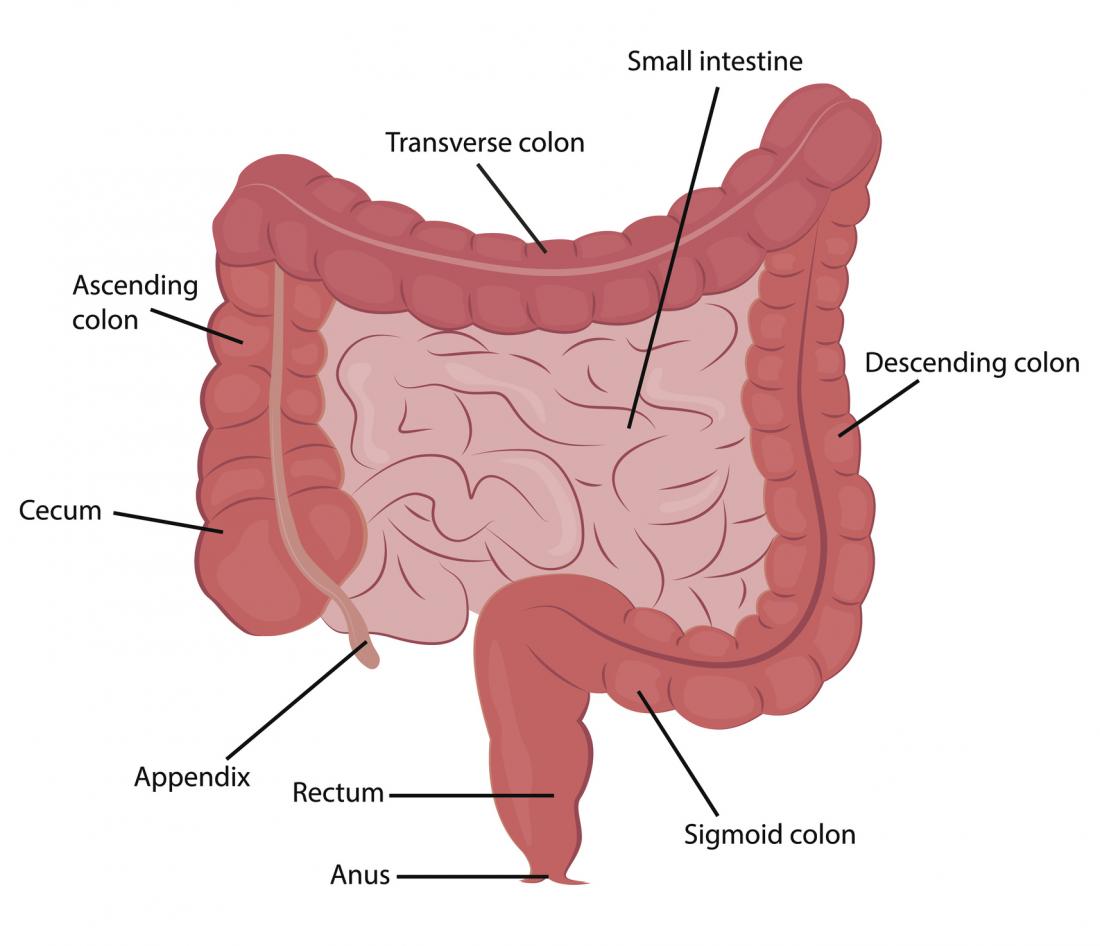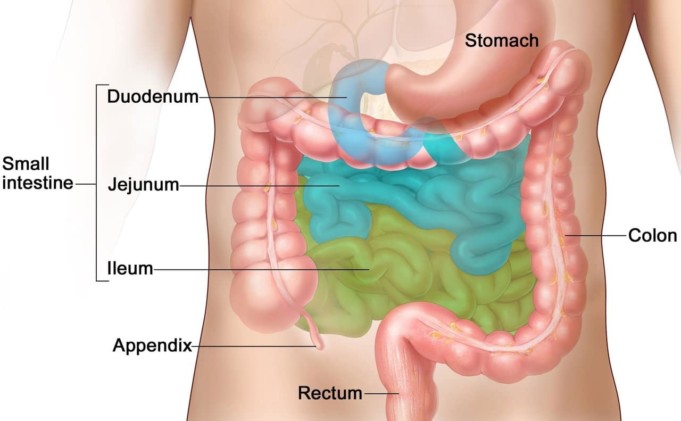The small intestine which is also called the small bowel is one of the most important organs of the Gastrointestinal system. The gastrointestinal system is commonly known as the digestive system or the GI tract.
The small intestine is a tubular organ that is found between the stomach and the large intestine. It has many loops and coils and fill most of the abdominal cavity (stomach space).
The small intestine plays the major role in digestion of nutrient in chyme (broken down food particles mixed with gastric acid), absorption of food nutrient and receives secretions from the pancreas and liver and transports the residues to the large intestine.
Parts of the small intestine
The small intestine consists of three important parts: the duodenum, the jejunum and ileum.
- The Duodenum: The duodenum is the first part of the small intestine which is also the shortest part, about 25cm long and 5cm wide. It follows a C-shaped path as it passes the right kidney and the upper three lumbar vertebrae. Preparation for absorption by villi (small finger-like protrusions from the wall of the intestine) begins at the duodenum.
- The Jejunum: The jejunum is the second part of the small intestine; it is the proximal two-fifths found between the duodenum and the ileum. About 40% of the small intestine is the jejunum and plays a vital role in digestion as water is absorbed by the jejunum.
- The Ileum: This is the third and final part of the small intestine. The separation between the jejunum and ileum is not distinctive, the end part of the ileum opens into the large intestine. The ileum itself is very rich in lymphoid follicles and it is attached to the walls of the abdomen by a thin firm called the mesentery.
The Wall of the Small Intestine

The inner wall of the small intestine is as important as any part of the intestine, throughout its length appears soft and smooth due to many tiny finger-like protrusions called intestinal villi.
These structures are most numerous in the duodenum and the jejunum. They shoot from the walls of the small intestine into the roundabout space of the small intestine, contacting the intestinal contents.
Villus increases the surface area of the intestinal walls and greatly aids absorption of digestive products. The individual villi on its surface possess tiny microvillus which further strengthens the surface area of the wall of the small intestine for effective absorption.
Function of the Small Intestine
The small intestine is majorly involved in the digestion and absorption of food nutrients. That is why about 90% of food absorption takes place in the small intestine.
It also receives bile and pancreatic secretions from the liver and pancreas respectively.
Digestion of food by the Small Intestine
Enzymes (chemicals) secreted by the small intestine and the pancreas are used in digestion. The small intestine uses this different enzymes and processes to digest protein, Lipid (fats) and carbohydrate.
From the Pancreas through the pancreatic duct the enzymes enter the small intestine in response to hormone (also a chemical secreted by the body), which is released in response to the presence of nutrients; this hormone is called cholecystokinin.
As a defensive mechanism, another hormone called secretin is released at almost the same time to act as a counter measure to neutralize the harmful acid released by the stomach. The major classes of food that are digested by the small intestine are as follows:
- Carbohydrates: This classes of food are broken down into what is called simple sugars and digested separately by different enzymes. For instance the commonly known glucose and galactose (monosaccharides) are absorbed directly by the small intestine, an enzyme called amylase breaks down starch (a class of carbohydrate) into lactose, fructose, raffinose, maltose; these are collectively called oligosaccharides. While other known classes of carbohydrates pass down into the large intestine undigested, some are not digested at all for example cellulose. Humans lack the enzyme to break down cellulose due to its complex structure whereas herbivores (herbs consuming mammals) easily breakdown cellulose in their digestion.
- Proteins: They are also broken down in simpler structures like peptides and amino acids before they can be absorbed into the body system. The breakdown of protein actually starts in the stomach and continues even into the large intestine. Enzymes responsible for breaking down proteins are trypsin and chymotrypsin which are produced by the pancreas.
- Lipids (fats): They are broken into fatty acids and glycerol by lipase; an enzyme secreted by the pancreas. Lipase works in hand with salts from bile (produced from the liver and gallbladder) to break down fats.
Absorption of food by the Small Intestine
As earlier stated, villi greatly increase the surface area of the intestine walls, making the small intestine the most important organ for absorbing food nutrients in the digestive system. Absorption of the end product of digestion mainly takes place through the villi of the ileum.
Different types of biological processes are used by the villi of the intestine for absorption of food nutrients.
Note that, diffusion and active transport into the blood are the two main processes involve in the absorption of food nutrients. From the villi blood vessels join with other blood vessels to form larger branches of vessels (like a tree) which deliver absorbed food to the liver.
Fatty acids and glycerol’s (from fats) follow the process of diffusion into the inner cells of the villi and are transported by lymph (a clear and colorless fluid that bathes tissues of different organs).
Other nutrients are absorbed and transported as follow:
- Monosaccharide (carbohydrate): They are absorbed through diffusion and active transport and are transported into the body by means of blood in capillaries (blood vessels for transportation).
- Amino acids (protein): They are absorbed through active transport process by the villi and are transported into the body by means of blood in capillaries.
- Electrolytes: They are minor food nutrients like vitamins and minerals which are absorbed through diffusion and active transport and are also transported by blood in capillaries.
- Water: Water is absorbed by the villi through a process called osmosis and like all other nutrients; it is transported by the blood in capillaries.
Controversies in Absorption by the Small intestine
It will be helpful to know that in Malabsorption, the small intestine digests, but does not absorbs some nutrients.
Symptoms of malabsorption
Symptoms of malabsorption may include:
- Diarrhea
- Weight loss
- General body weakness
- Deficiencies in vitamin. Some patients may also experience anemia and bone demineralization.
Causes of malabsorption
- Surgical removal of a portion of the small intestine
- Obstruction of lymph or blood vessels due to a tumor
- Interference with the production or release of bile as a result of a liver disease
- Celiac disease: An allergic reaction to gluten which is found in certain grains, it can result to damage of microvilli and in severe cases villi may be destroyed.
Conclusion
The small intestine is the most important organ in getting the important nutrients needed in our everyday lives. It cannot be bypassed as its functions in digestion and absorption cannot be over emphasized.
So, in other to keep this hidden but obvious organ healthy, it is advisable to eat healthy especially looking out for the gluten-free food products like pasta and baked goods.
References;
- Third edition Cambridge biological science
- The-small-intestine; wikipedia.org
- McGraw-Hill Higher Education, Hole’s Essentials of Human Anatomy & Physiology Tenth Edition












